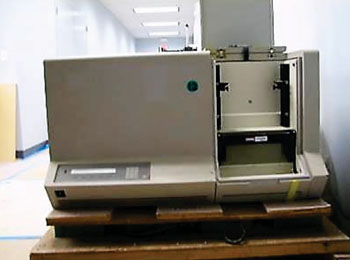Nosocomial Environmental Contamination by MERS-CoV Investigated
By LabMedica International staff writers
Posted on 04 Jan 2016
Although Middle East Respiratory Syndrome coronavirus (MERS-CoV) is characterized by a risk of nosocomial transmission, the detailed mode of transmission and period of virus shedding from infected patients are poorly understood. Posted on 04 Jan 2016
The potential role of environmental contamination by MERS-CoV in health care settings and defining the period of viable virus shedding from MERS patients has been investigated using reverse transcription polymerase chain reaction (PCR), and isolating viable virus by cultures.

Image: Applied Biosystems ABI 373 XLDNA sequencer (Photo courtesy of Perkin-Elmer).
Scientists at the Chungbuk National University (Cheongju City, Republic of Korea) and their colleagues enrolled four laboratory-confirmed MERS patients, hospitalized in two hospitals from June 8, 2015, to July 3, 2015. Respiratory specimens and environmental samples were collected and cultured from all patients during the later stages of clinical disease. Viral ribonucleic acid (RNA) was extracted from all samples and MERS-CoV and the RNA amplified and quantified. Amplicons were purified and sequenced on an ABI 373 XLDNA sequencer (Perkin-Elmer; Foster City, CA, USA).
Many environmental surfaces of MERS patient rooms, including points frequently touched by patients or healthcare workers, were contaminated by MERS-CoV. Viral RNA was detected up to five days from environmental surfaces following the last positive PCR from patients' respiratory specimens. MERS-CoV RNA was detected in samples from anterooms, medical devices, and air-ventilating equipment. In addition, MERS-CoV was isolated from environmental objects such as bed sheets, bedrails, intravenous fluid hangers, and X-ray devices. During the late clinical phase of MERS, viable virus could be isolated in three of the four enrolled patients on day 18 to day 25 after symptom onset.
The authors concluded that most of touchable surfaces in MERS units were contaminated by patients and health care workers and the viable virus could shed through respiratory secretion from clinically fully recovered patients. These results emphasize the need for strict environmental surface hygiene practices, and sufficient isolation period based on laboratory results rather than solely on clinical symptoms. The study was published on December 17, 2015, in the journal Clinical Infectious Diseases.
Related Links:
Chungbuk National University
Perkin-Elmer














